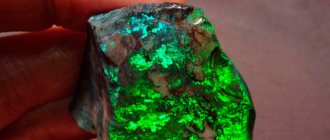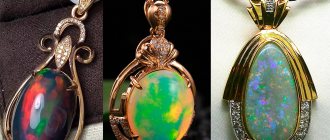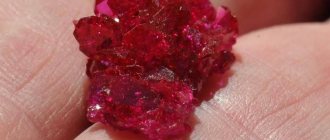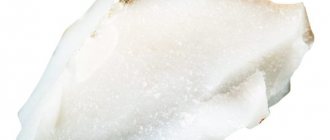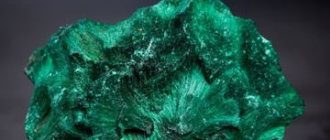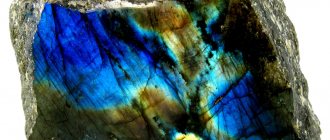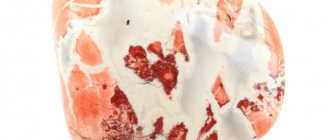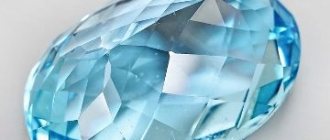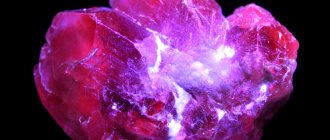If you want to buy real opal, you may find that it is unaffordable. Then purchasing an artificial stone would be an excellent solution. Imitations come in different forms, some are not much cheaper than the original, and they are even successfully passed off as a natural mineral. In this article we will tell you in detail how synthetic stones are produced, what their cost is and how you can recognize a fake when buying jewelry. You will also learn about all the advantages and disadvantages of such products.
What is synthetic opal?
Externally, synthetic opal is practically indistinguishable from natural opal. High-quality fakes have physical characteristics identical to the mineral, with some improved features.
The color palette of synthetic stones includes any possible shade. Tone is imparted by diffraction without the use of dyes.
In artificial gems there is an increased density and there is no water in the composition.
In addition, the breed has certain advantages over its natural counterpart:
- cheapness;
- bright, rich color;
- beautiful shine;
- resistance to external factors;
- hardness.
How the gem was created
Synthetic opal ring
Humanity learned to artificially reproduce opals back in ancient times. In Ancient Rome, cheap analogues of the mineral were made from hot glass. To do this, it was heated and sharply cooled to simulate microcracks and inclusions characteristic of the stone.
The patent for the production of artificial opals was first acquired by mineralogists from Australia A. Gaskin and P. Darré in 1964. At the first stage of the synthesis, scientists produced silica spheres of the required size. Since the balls formed under artificial conditions contained more water than in natural opal, the next step was dehydration and gluing of the spheres using heating.
Around the same time, scientists in Delaware succeeded in producing spherical silica particles with an ideal diameter of 0.1 microns. In the intermediate layer between the balls, the bright colors of noble natural opal were observed. Addition of hydrochloric acid to the solution resulted in the formation of solid particles with a full spectrum of colors. This is how the first lab-grown opal appeared, with the play of colors characteristic of the rock.
The synthesis process was improved and was later supplemented by the use of organic silicon compounds with the addition of ammonia. Heating technology continued to be used to compact the balls in order to reduce the voids between them.
Synthetic opal
And in 1973, the Swiss organization of Pierre Gilson began producing high-quality synthetic gems in a wide variety of variations. Gems are in no way inferior to natural ones and even have opalescence. Gilson samples are characterized by a certain porosity. The stones become transparent only after immersion in chloroform. The color of the stones is close to natural samples of black and milky white. The patterns and opalescence are also almost identical to the originals.
There are four leading manufacturers in the world:
- The Japanese company Kyotsera, famous for opals made from various layers, impregnated with transparent colorless rubber.
- Slocum, which produces rock from a special glass with a velvety shine.
- Gilson's company. Creates stones from layers of natural opal with an artificial base.
- Inamori Corporation, which reproduces a breed almost identical to the natural one in chemical characteristics.
These organizations produce the best quality gems. Only they use substances contained in natural opal in production.
Artificial gems are also produced in Russia and China. But they make them from polymers and glass.
Synthetic crystals: creation and history of appearance
For natural opal to form, many millennia must pass, but even then it is not a fact that the result will be a high-quality stone. Therefore, people have long been thinking about how to create artificial jewelry. To do this, it was necessary to carefully study the structure of the mineral, which became possible only with the advent of electronic magnifying devices in the second half of the 20th century.
The first patent for the creation of artificial opal was received by Australians P. Darre and A. Gaskin in 1964. They were able to produce silica balls of a given size. In this case, scientists took sodium silicate in the form of a solution and deionized it by heating it at a temperature of 100 degrees with ion exchange resins. The process was long - up to 100 hours. The resulting crystals contained too much water, so it was evaporated by keeping the stones at temperatures from 100 to 600 degrees.
During these same years, the Americans G. Siret and R. Eiler, who worked at Dupont de Nemur, also obtained artificially silica particles, which were then pressed into opal. They added hydrochloric acid to the solution and for the first time obtained crystals with the bright shades characteristic of opal.
It is difficult to distinguish an artificially grown stone from a real one. Although it is more porous and dense, it is impossible to determine these properties without special instruments. When purchasing, pay attention to how the crystal transmits light: the radiance of natural stone is brighter, more varied, more changeable, the color saturation is zoned. Also, upon careful examination, you can see that the structure of a laboratory gem is similar to a mesh or reptile skin.
Today, artificial stones are made on an industrial scale in the following countries:
- Japan;
- USA;
- China;
- Russia.
Their prices are several times (and sometimes hundreds of times) lower than for natural gems.
Properties of synthetic Gilson opals
Gilson opal The
Gilson company produces opals of all categories: from rare black to crystalline white opal, which, according to many gemologists, is the most refined. The laboratory conditions in which it is produced are identical to those in which opal is formed in nature. This process takes 14 to 18 months and the colors are natural and appear as in natural opal by diffraction rather than by pigments.
Unlike its natural counterpart, synthetic opal is denser, it does not contain water and is not prone to cracking. Natural opals contain up to 10% water.
The fact today is that synthetic opals are affordable and come in a wide variety of variations. Many people believe that their beauty, hardness and insensitivity to heat are their undoubted advantages.
Stones produced by Gilson and Kiotser
In the early 70s, after four years of research, the Frenchman Pierre Gilson announced the successful creation of a stone similar in properties to natural. It takes a year to form such stones, but their microstructure is similar to real ones: they consist of silica balls. The difference from the first artificial gems is that these balls do not consist of even smaller particles, but are monolithic. This reduces the porosity of the crystal, increasing density.
Synthetic Gilson opal is thus less porous and more durable than natural opal, and is wear-resistant. Gilson stones are black and white and have opalescence. Many of them are opaque and become transparent when dipped in chloroform.
Kyocera crystals are created according to the same principle as Gilson's, differing in that they are impregnated with a special composition - transparent colorless rubber. They are durable, have much less impurities and foreign inclusions than opals of natural origin.
Such stones are in demand for creating jewelry and as decoration elements.
The advantages of artificial opal include its durability and color variety. And also durability, resistance to temperature changes and affordable cost.
The only disadvantage can be called the fact of artificial origin, which matters only if we are talking about prestige and you need natural stones.
Synthetic Slocum Stones
Slocum Opals
The American John Slocum was able to successfully imitate an opal stone. For many years he spent a lot of money on experiments with silicate materials, and his work was crowned with success. At first, Slocum wanted to create an artificial gem, but in the end he invented a special glass. It has a variety of shades, but is practically devoid of water, which means it is much stronger than natural opal.
To the eye, a Slocum opal is almost impossible to distinguish from a real stone. The nuances are visible under high magnification: iridescent colored spots in the imitation look like scattering or triangles, while in a natural crystal they are flat and have a velvety shine. All Slocum stones are different, as it is impossible to predict the color of the glass when it is formed.
Interesting Facts
The variety of beliefs is the reason that opal has become a mystical symbol in magic, alchemy, and is common in jewelry production. The word "opal" has Sanskrit and ancient Greek origins.
Interesting facts about opal:
- Opals are found in varying quantities throughout the planet, and in 2008 they were also found on Mars.
- For some time, tripoli was part of dynamite. The largest and most valuable mineral is worth $2.5 million.
- The opal is the official symbol of South Australia and the women's basketball team.
Legends about the stone:
- Ancient legends about Zeus contain a story about how, in the victory over the Titans, the deity's tears became opals.
- According to Australian legend, the Creator descended from heaven to impart his knowledge to people, and his every step on earth was indicated by the rainbow color of opal.
- According to Indian legend, the goddess of love, hiding from persecution by men, scattered herself with beautiful stones.
Russian synthetic opals
Russian synthetic opals
Scientists from the Institute of Solid State Physics of the Russian Academy of Sciences, located in the science city of Chernogolovka near Moscow, have developed a unique technology for producing synthetic opals. With its help, you can not only synthesize opals, albeit very beautiful ones, but also create opal matrices with a predetermined nanostructure, opening the way to materials for optoelectronics, magnetic recording systems and other fields of science and technology.
The basis of the new technology is the production of tiny, ranging in size from tens of nanometers to several thousand nanometers, beads of silicon dioxide. By changing the size of the balls, you can influence which wavelength of light the opal will absorb and which wavelength it will reflect, including in the visible region of the spectrum.
Which opal to choose: natural or synthetic?
Synthetic opal jewelry set
The final decision on choosing natural or synthetic opal is made by everyone at their own discretion, depending on their goals, requirements and capabilities. If you want to enjoy wearing a natural stone with an unusual play of colors, amazing magical and healing powers, powerful energy and an individual appearance, you need natural opal. The price is steep, but the stone and jewelry with it are worth it.
If you don’t believe in the magic of minerals, don’t think about energy, and don’t understand the intricacies of gemology, imitation opal in a beautiful frame is a justified decision in every sense. The main thing is to choose jewelry at an adequate price from a manufacturer who does not hide the fact that imitation is used and does not require you to pay the same amount for it as for natural opal.
Jewelry with synthetic opal
Synthetic opal jewelry
High-quality imitation is a good solution for those who love jewelry with opal, but cannot afford to buy a natural mineral.
Combining jewelry with artificial stone is not difficult because of the variety of colors in which they can be made.
Synthesized opal is extremely rarely set with precious metals.
More often these are light bracelets or other types of jewelry.
You can wear the product with any outfit. The breed will never look pretentious or inharmonious. Jewelry goes well with everyday wear.
Why were artificial crystals needed?
The need for synthetic opal arose due to the high cost of the natural mineral. The high price is due to two reasons. Firstly, opal is a rare stone; it is mined in few places: almost all natural material comes to the jewelry market from Australia, and Ethiopia has a small share of the market. A small amount of stones is supplied by Brazil and the USA.
Secondly, opal has an unpleasant feature - it is fragile. Many samples crack during extraction from the rock, and even more during processing and polishing. It turns out that out of many crystals, only a few pieces end up in jewelry. At the same time, the demand for opals is huge, and products with it are considered elite. The discrepancy between supply and demand was the reason for the appearance of synthetic stones.
The main value of opal is its variety of shades. From Latin, the name means “bewitching look”; there are 140 varieties of the gem. As for the composition, the real stone is amorphous silica. It contains silicon oxide and up to 30% water. Essentially this opal is a hardened gel. Interestingly, he is able to age. "Older" opals are known as chalcedony.
Read more about this amazing mineral in the article “Opal Stone: Properties and Who is Suitable for It.”
Product prices
Rings artificial opal blue
Natural opal is several times more expensive than artificial opal. The cheapness of the stone is another advantage over its natural counterpart. Artificial stone jewelry can be purchased for about $10.
Making products using synthesized stone makes them affordable, and customers are satisfied with the quality and appearance of the reproduced opal.
A noble imitation - synthesized opal - is a justified solution for those who love beautiful jewelry with opal, but cannot afford to buy a natural original.
The only drawback of artificial stone is the lack of magical and healing properties.
Applications
Opal is used in the jewelry industry, and small fragments are used in beauty salons to decorate nails. Polished stone plates are attached on top of onyx, obsidian, and black glass. Due to its low strength, opal was impregnated with artificial resins, oils were applied to its surface, and strong frames were made for it.
Stone chips and small specimens can serve as decorations for buttons, hairpins, brooches, cufflinks, wallets, caskets and other accessories.
Rocks containing opal - diatomites, tripoli, opoka - raw materials for the production of cement and other building materials.
How to care for stone
Jewelry with unnatural stone is easy to handle and very durable. Therefore, there will be few rules for caring for it:
- Clean the product with soapy water whenever it becomes dirty. It’s not scary if you use soap and a toothbrush, but it’s better not to overdo it.
- The only reason opal should be stored separately from other stones is because they can scratch natural minerals.
- But try to avoid mechanical impacts on the breed. Even a synthesized gem can crack or chip.
A variety of imitation opal: doublets and triplets
Opal doublet blue
A common type of counterfeit opal on the jewelry market are doublets. Although this is only half an imitation. This product consists of an inexpensive dark stone (usually onyx) and a plate of natural opal, which is glued on top. As a rule, black opals are imitated in this way.
Triplets consist of three components. First, an opal plate is glued onto a dark substrate made of another stone, and then a transparent dome made of another material, most often quartz glass, is glued on top. This product costs much less than natural opal.
To fasten the parts, a durable epoxy adhesive is used that is not exposed to water, solvents and acids. However, doublets and triplets cannot be kept in water for a long time, since it penetrates into the space between the glued parts and eventually destroys them.
Other methods of counterfeiting: glass and smoke
Among the ways to pass off a cheap crystal as a noble crystal, the leader is the impregnation of low-quality, nondescript opals with smoke. This is how stones from Ethiopia are usually refined.
Opal has a porous structure. Due to this, soot particles from the smoke penetrate into it, making the crystal dark, while simultaneously increasing the opalescence many times over. At the same time, it is easy to distinguish such a pebble from a natural one. Opals with a black background are practically never found and cost a lot of money.
Even cheap, low-quality opals are colored with conventional chemical dyes. Such samples produce bright, unnatural shades of blue, pink, yellow, and purple.
Imitations are also made from glass by first heating it and then sharply cooling it. This is how stones are obtained for jewelry, which is sold at a low price. These jewelry are available to any buyer, unlike fakes based on natural opals.
How to distinguish natural opal from synthetic one
Artificial opal pendant
Synthetic opals, created by skilled craftsmen, are outwardly indistinguishable from natural gems, so there are often cases of deception of buyers by unscrupulous sellers. In some cases, imitation can be determined by eye, knowing the features of the appearance and structure of the mineral. However, manufacturing technologies do not stand still, and sometimes, in order to identify a fake, it is necessary to conduct a gemological examination.
There are a number of ways to determine the authenticity of a stone, allowing you to avoid purchasing a fake at the price of natural opal. You can check the origin of a precious item using the methods below.
- Does the stone stick or not ? One of the most original ways to verify the authenticity of a mineral is to “lick” the stone. To determine the natural origin of the gem, it is applied to the tip of the tongue. The imitation opal will stick to the tongue for a couple of seconds, but this will not happen with a natural specimen. It is unlikely that it will be possible to use the verification method in a store, so the method is only suitable for determining the origin of a stone at home.
- Pay attention to the pattern . Natural opals are distinguished by the play of light and unique, non-repeating patterns on the surface. The stone will flicker and “play” in the rays of the sun, while the color should remain uniform. You can recognize an artificial mineral grown in a laboratory by carefully examining it. If the patterns are the same or repeated, and the brightness of the background color changes, then it is an imitation and not a real gem.
- How to recognize doublets and triplets . Artificial opals created by refining have “seams” in their structure. These are zones for gluing elements of natural stone and iron base. If you turn the fake on its side, then, looking closely, you can see thin stripes - the junction of the films.
- Transparency test . You can distinguish natural opal from artificially grown opal by assessing the purity and transparency of the stone. A real gem should be translucent or completely transparent, especially if the color is milky white. If the opal has a dark-colored backing visible in the light, then the product is made of synthetic materials. The origin of the mineral is also verified using daylight. The rays passing through the stone are refracted and color the hand in different shades, but in the case of imitation there will be no such effect.
- Unnatural colors . Growing synthetic stones makes it possible to paint the mineral in different colors of any saturation and shade, but the palette of real opals cannot boast of such variety. You can distinguish a natural insert from a fake by its unnaturally bright color, for example, if the specimen is richly blue, green or pink.
- Overflows and bubbles . Natural stone stands out with soft tints and radiant shimmer in daylight. Synthetic opals have a more obvious zonation of color - sharp transitions of shades are visible on the surface of the gem, which is a sign of a fake. Upon closer examination of the imitation under a magnifying glass, you can see round air bubbles - microcracks formed during the manufacturing process of the fake. In a real opal there should not be such bubbles.
- Product price . Due to its rarity and beauty, natural opal is expensive. The average price is the same as that of gold, and even higher for individual pieces. You can identify a fake by finding out the cost of the product, especially for black opals. This species is rare, so its price is high, and coal-black stones are not sold in ordinary stores. At special auctions, the cost of dark copies starts from $2,000.
5 / 5 ( 9 votes)
Description of artificial opal
The magic stone has fallen.
The description of a fake opal depends on the material from which it is made. However, the manufacturer always tries to bring the imitation closer to the original. The latter has an unusual property - luminescence.
It is capable of emitting light, which enhances its color. Precious stones additionally shimmer with all the colors of the rainbow. They try to give this effect to almost all imitated specimens.
Varieties and colors
The most common are glass and plastic counterfeits. Less commonly, synthetic opals are grown in laboratories. The stones come in a wide range of colors.
The most valuable examples are red, orange and purple, so these shades are often found among imitations. Opals can be yellow, blue, green, black, white, pink, etc. When exposed to light, they shimmer in all shades of color.
